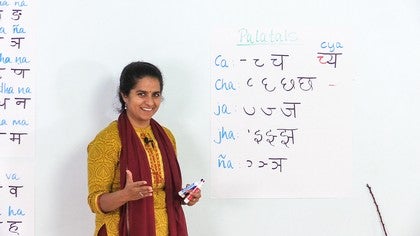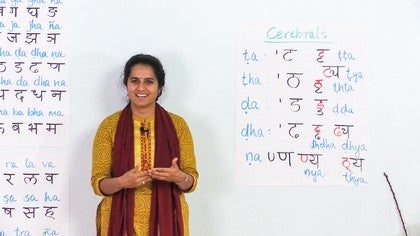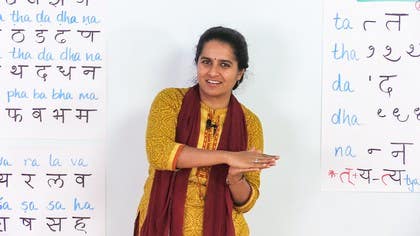Description
About This Video
Transcript
Read Full Transcript
Namaste dear friends. Welcome back again. I sincerely hope that you've been practicing with your guttural sounds and that you're getting much more confident and feeling at ease, at writing them out, at sounding them. You have five days in a week, six days, seven days. So I hope that what you can do with these letters is use one letter, take it up, paste it up somewhere in your house where you can see it regularly. Close your eyes, try and visualize it as much as you can. When you're driving down, you're stuck in a traffic jam, you know you can just stop, say the letter, see what it looks like. You'll make very good use of your time. Investing in Sanskrit is always a good investment, anytime, anywhere. So there we go. We had just looked at the guttural and we saw where they corresponded to in our throat. And we also know that there are the other ones.
There are the palletals, the cerebrals, the dentals and the labials. Now that we've seen the five guttural that correspond to your throat, we can move on to the next five letters that correspond to your pallet. So they are the palletals. As we mentioned briefly last time, when pronouncing a consonant which implies an element of touch, unlike a vowel which is an open sound, there is the concept of the sparsha in Sanskrit. Sparsha meaning touch. There is also the added notion of prayatna or the effort or the breath that you put into it. So we have sparsha, prayatna and then when it combines with the vowel, we also have an added element of time because you have short vowels and the long vowels. So you get kala or time. So sparsha, prayatna and kala. Touch energy into it with your breath and the time.
Keep that in mind as you use these sounds, as you use the different letters of the Sanskrit alphabet. So next we will have a look at the ch. The ch is the palatal ch. With the breath, you get the ch. Then it becomes a voiced or when you sound it first, you get the j. Add your breath. And then the nasal sound. The good thing is that with this group, with every group actually, not just this one, but with every group, you just need to keep your tongue in the same place and vary the combination of your breath and the time that you say. And you will get the letters smoothly. So just once quickly again, you can say along, ch, ch, j, j, nya. I'm excited. Let's see what they look like. So we have the palatals.
So the first palatal that we saw was the ch. It starts with a small dash. So what I would be doing basically is taking you through the letter but stroke by stroke so that you can really know the order in which it is written. General information is that you always go from left to right. So we have the one, two and the stick. Ch. That's the ch. See that? Ch. As you're saying it, try and visualize the letter as well because that helps to form greater connections within your brain and it will stick better with you. The second sound is the ch. And that is written like this. One. It's like a sleeping three a bit. Reverse. Two. And there's a tail. A tail and a small thing there and you put the line across. Ch, ch. You will notice that it looks quite similar to the gh that we saw with the guttural group.
We have the gh which has a stick beside it. So you have a sleeping reverse three a little and then you have the stick. That is your gh. But when you write the ch, the stick turns into a tail and then you add a small t. That is the ch. The following letter is the j. One tip on this is that it looks a bit like the jug. See there it is. It's something that you hold and it can contain some water in it. So it's like the jug. It's a j. So you start like that. One. Two. And three. There you are. So that's the j. Say that again. J. We move on to the next letter which is the j. The j is like the e. We had an e when you learnt the vowels. I hope you've been practicing and that you have the vowels clearly with you now.
So you know that the e looks like that. Like the snake with the tail. And then you just have to add a bridge and make that extra t there. So it goes like this. One. The snake with the tail. Two. The snake with the tail with the small bridge. Three. And then snake with the tail with the small bridge and the t. That is the j. You just have to try and bear in mind that when you're writing it, try and keep the letters even. So try and make them of the same length. It adds to the beauty, to the aesthetics of the written part. The last in the series is the nasal palatal which is the nya. In this series we will see that in these five letters you have a certain similarity in them. If you look at the combination of the ch, the j and the nya, you will notice that you have the c.
There are different ways of playing with the c and the dash combinations. So here you have the dash and then that sleeping c. Here you have the reverse sleeping c and then the dash. And here you have the c and then a dash and the stick. So see if you can remember that. These are just small tips that might be helpful. But you can always develop your own and just use your creativity to see what works better for you. So we have the c, the reverse c, 1, 2 and the t, nya. Always remember that the line on top should try and cover the letter. So there we have the nya. You will also notice that in the diacritical I have put in a small wave on the n and that is because in the Sanskrit alphabet we've got five variations of the nasal sound.
So we have the n, which is the guttural nasal. Then you have the palatal nasal, the nya. Then you have the cerebral nasal, which is the nna. You have the dental nasal, which is the nna. And then you have the labial nasal, which is the m. And in the English language we just have one n. So in order to distinguish the different sounds, we use these different dots, the different combinations, dots and waves so that it becomes clear to anyone who is reading Sanskrit, which is the place of pronunciation for that particular letter. So we have seen that and now we will try and see that when you combine these consonants with other consonants, what happens? When these consonants stand alone or they are combined with the vowel er, they look like that. You see, there is a vowel er here. So that is the independent consonant. Now when you have a half consonant that combines with another consonant, what happens? So we'll keep the consonant here.
So when the chir becomes half, it looks like that. The rule is that if there is a stick, the stick has to drop. So that's the chir here and we will add the consonant here to that. I hope you can see that clearly. So that is the chir and I'll write it out for you in transliteration. So that's the chir and that is your yir. Now with the chir, it never really becomes half. So we'll not even go into it because you don't see it really anywhere as a half letter. So we can skip that. And then we move on to the jir. So when we come to the jir and it's half, guess what will happen? Yeah, you have to drop the t and attach it to the next letter. So we have j and the consonant here which is jir. There you go. So that is the jir. With the jir, can you guess what will happen? Yeah, you said it.
So you write the jir and there is the stick. The stick drops and the letter comes through. Yeah, that's the jir. Again, this is a combination that you will never ever encounter. The sound jir is not so common in the Sanskrit language but it is there. And then we come to the nir, the last one. And if you had to guess, yeah, you said it right. Half the letter and then the, that will be the, now that is a real imaginary sound. You will never really see that. But we have it here. I'll give you a more realistic example. You see the word vyanjana which means the consonant. We have the combination of nir and the jir and see what happens. The nir becomes half and the jir comes under it. Got that? So you have the nj. That's what would basically happen. So we can repeat it once more. You just say the ch, ch, j, j, nya.
What I recommend we do is that you try and draw out these letters with your body as well as you learn them through. So with the ch, just imagine that you are representing the whole thing with your body. Just one small note. Don't mirror me because if you mirror me, you will end up writing the letter backwards. So move from your left to your right and reproduce this picture. So close your eyes and say ch. If you are a right handed person, you might like doing it with your right hand. If you are a left handed person, you might like doing it with your left hand. Or if you are a right handed who wants to develop your left side, you can still write it with your left hand and vice versa. The more you play with this, the more it integrates the different parts of your body. So just enjoy doing it. In terms of the psychological significance of these sounds, the sound ch corresponds to the power of emotion. It's the initial movement.
The ch power of emotion with greater force. The j represents the power of reaction, the initial motivation. The j power of reaction with greater force. And the nya is the manual of artistry and grace. So practice these letters. Develop these qualities in yourself. Enjoy them. Sound them, write them, feel them, feel them, discover them in your lives. See you again. Poonar Mila Maha. Poonar Mila Maha is see you again.







You need to be a subscriber to post a comment.
Please Log In or Create an Account to start your free trial.